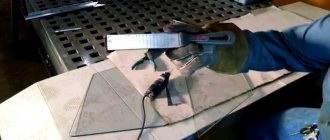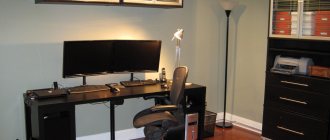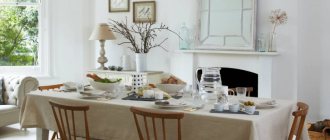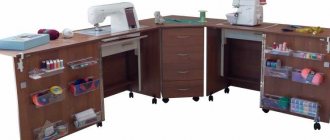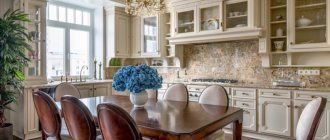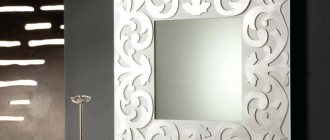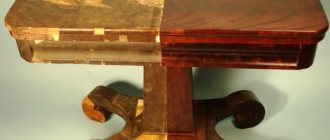In modern kitchens you can find countertops made of artificial or natural stone, glass, stainless steel, ceramic tiles, but most often solid wood or chipboard sheets lined with plastic are used as the main material. If you don’t know how to protect a capricious surface, there is a risk of its deformation and rapid destruction under the influence of moisture and other negative factors.
Following the basic rules for caring for raw materials will help avoid unpleasant consequences. In addition, there are many effective approaches that help improve the quality of the product and its resistance to external influences.
General information
The oilcloth for the table is made from laminated protective transparent PVC film. Production - South Korea.
The product has a shiny laminated surface and reliably protects the table from any damage. The oilcloth structure is flexible and durable. It is tear-resistant, practically does not wrinkle and cannot be cut with a knife. Soft glass remains transparent for a long time and retains all its properties.
Thanks to the flexible tablecloth, wear and tear on the tabletop is reduced. Dust on the surface covered with a protective film is practically invisible, any dirt can be easily wiped off without scratching or staining the table material.
Where can I use it?
Flexible glass is intended for use:
- in any office;
- in the kitchen;
- in the dining room;
- in a restaurant (cafe).
Which table is it suitable for?
Protective film is suitable for all types of tables, but is especially relevant for glass and lacquered ones. The tablecloth protects the kitchen table from cuts, the desk from rubbing, and the dining table from accidental stains.
It can also be any table in shape:
- rectangular;
- square;
- round;
- oval;
- non-standard shape.
Tip On a rough surface (for example, unpolished wood or textured PVC film), flexible glass will constantly slide. To hold it, you will have to use gentle glue.
Main characteristics
Before purchasing the product, you must select the thickness:
- 1.2 mm is used to protect chests of drawers, window sills, children's and school tables;
- 1.8 mm is well suited for the kitchen (protection of tables and countertops), children's (protection of desks) and office (protection of tables and window sills);
- 2.2 mm is designed to protect large surfaces and helps emphasize the premium quality of the interior.
Liquid glass on the table has the following characteristics:
- Duration of operation - up to 5 years;
- transparency - 98%;
- hardness - 37;
- blue pigment that protects against yellowness;
- resistance to sunlight;
- food standard - the material is allowed for contact with food;
- synthetic smell - absent;
- There are no heavy metal impurities in the composition.
Advantages of flexible glass
Main advantages of the product:
- easy to trim after shrinkage;
- has a comfortable temperature range - from –20 to +80;
- merges with the surface;
- just spread out;
- does not slip, lies well under its own weight;
- greasy stains are not eaten away;
- any dirt is easily removed.
If you want, you can decorate the tablecloth. Any stickers can be easily attached to the silicone surface. You can also paint it with permanent paint, or attach fringe around the perimeter.
Main disadvantages
Over time, the film may shrink. This happens even against the backdrop of careful operation and proper maintenance. The color of the film becomes cloudy, and the product itself takes on a sloppy appearance.
The deformation cannot be corrected, and therefore you have to purchase a new tablecloth.
Rules for choosing a tablecloth
In order for a tablecloth to last for a long time, it must be chosen correctly. Therefore, when choosing, you should consider several important recommendations:
- durable base - the coating must have a dense structure that can withstand various cuts and high temperatures;
- The water-repellent tablecloth for the kitchen table has good qualities. The waterproof layer will ensure long-term wear of the table;
- The oilcloth should not be sticky, otherwise it may stick to the table and in the future difficult to remove stains may remain on it. In addition, the adhesive oilcloth is of low quality;
- shape - the shape of the coating can be different, the main thing is that its parameters fit the size of the table;
- It is better to purchase an expensive coating - the high cost speaks volumes about the true quality of this product. The lower the price, the lower the quality;
- design - you definitely need to pay attention to the color and pattern of this product. It is important that the tablecloth matches the style of the kitchen. If the kitchen has warm colors, then the oilcloth should be made in warm colors. If the room is dominated by cool colors, then the tablecloth should be purchased in cool tones.
Main manufacturers
Information about the main manufacturers is presented below.
Table. Advantages and disadvantages of leading brands of liquid glass for the table:
| Parameter | Comparative characteristics | ||
| DeVetro | Decosave | Silikonka | |
| Description | The film is produced at the PVC film plant for food production | Film thickness - 2 mm. Designed for kitchen tables | Designed to protect work and kitchen tables, school desks, holiday tablecloths, reception counters, store counters, and bar counters. |
| Advantages |
|
|
|
| Flaws |
|
|
|
Features of use
The packaging must be removed very carefully. The use of any sharp objects, especially scissors and knives, is prohibited.
In order to get the product you need:
- Carefully grasp the edge of the tape.
- Pull it towards you.
- Remove the remaining film.
- Clean the tablecloth from dust.
Laying the material
Flexible glass is installed on a stone, metal or wooden surface as follows:
- Place the film on the table.
- Moving towards the edges from the center, press down. This will help avoid air bubbles.
- Wipe the table covered with liquid glass with a damp cloth.
The film is laid on a tabletop made of glass as follows:
- Clean the surface from dirt.
- Place a tablecloth on the table.
- In places where bubbles collect, spray with water from a spray bottle. Against the background of additional moisture, the tablecloth quickly sticks to the tabletop.
Trimming material
In order to cut the glass to the required dimensions, you will need the following tools:
- roulette (ruler);
- marker;
- knife (stationery).
The film is cut on a cutting board.
The instructions look like this:
- Measure the countertop.
- Make patterns on paper.
- Cut out the material.
- Cover the table.
It is necessary to measure the tabletop several times. You need to use the average value. When cutting a layer, you need to take into account the errors that appear as a result of measurements. This will help avoid damage to the material.
Trimming is carried out using a stationery knife, small defects are eliminated with scissors.
A way to remove scratches from thick glass
The impressive thickness of the glass allows for grinding work. This restoration method is labor-intensive and time-consuming, but guarantees a high-quality result.
Stages of work:
- Clean the glass with a special window cleaner.
- Set the drill with the polishing disc to minimum speed.
- Sand the scratch.
- Apply a small amount of GOI paste to the disc.
- Polish the area to be treated using circular movements.
- Rinse the surface with the defect removed with water and ammonia (10 drops per glass of water).
- Wipe dry with a lint-free cloth.
Features of care
Despite its resistance to the adverse effects of chemical compounds, liquid glass is a soft material. Proper care helps extend its service life.
Basic Rules:
- The water temperature for processing the tablecloth should be room temperature or about 40 °C. This helps accelerate the impact of detergents;
- The material can only be wiped with soft cloths and napkins. Products made from microfiber and flannel are best suited. You can also use sponges made from foam rubber. There should be no hard inserts;
- After cleaning the surface, it is necessary to remove any remaining detergent. This will help reduce the risk of clouding and streaks;
- It is necessary to treat the surface with gentle liquid agents - solutions and gels. Do not use preparations with active granules, as well as hard powders;
- severe contamination must first be treated with the product, then left for 5-15 minutes, only then carefully wipe with a soft cloth. You can't put in any effort.
It is advisable to purchase a tablecloth on the official website of the manufacturer, because counterfeits may be sold in retail stores. Before purchasing, you should carefully study the reviews and reputation of the manufacturer.
Liquid glass on the table is a good solution for both the kitchen, children's room or office. The main advantage is resistance to moisture and abrasion. Such protection is especially useful for glass and polished tables. On a desk, such a film will successfully replace plexiglass. It is transparent, but impenetrable to dust, water and various contaminants, so it will extend the life of the countertop.
How to protect a wooden table
The varnish coating adorns the wood. With it, the wood texture appears more clearly, the color becomes more saturated, and a specific gloss appears. The most important thing is that the coating protects the wood, and with it the service life of the wooden panel increases to 10 years.
Varnish coating decorates the wood
There are many factors in the kitchen that negatively affect wood: water, hot objects, sharp objects. High humidity and processes associated with cooking provoke the appearance of fungus on wood. The varnish coating protects from all this.
There are many factors in the kitchen that negatively affect wood: water, hot objects, sharp objects.
This type of wood processing is a very complex and labor-intensive process that consists of several stages. How to varnish a tabletop is an art. Since after the composition has hardened, nothing can be changed without a complete rework, the preparatory stages are carried out very carefully.
How to varnish a tabletop is an art.
The surface is completely cleaned, sanded and treated with a special chemical remover. After this, it is wiped with alcohol or acetone, which completely removes traces of fat. Then the composition is applied in three layers, each layer being given time to dry and harden.
The surface is completely cleaned, sanded and treated with a special chemical remover.
Important! The quality of the pre-treatment determines the protection of the wood under the varnish coating and the durability of the latter. Remaining grease or moisture can cause defects or rot in the wood.

